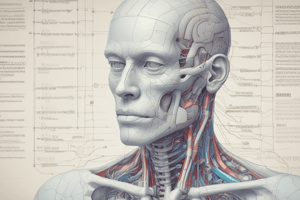Podcast
Questions and Answers
Match the following terms with their definitions:
Match the following terms with their definitions:
General = Acute Bronchitis, Renal Disease, Acute Infection, DVT, Chronic Edema Compression = Cardiac Edema, Arterial Disease, Spasticity, Acute Infection Neck = Hyperthyroidism, Carotid Endoarterectomy, CVA, Cardiac Arrhythmia, Carotid Sinus Syndrome Abdominal = Diverticulitis, Diverticulosis, Ileus, Inflammation large/small intestines, recent abdominal surgery, CHF, Children Under 12, Aortic Aneurysm, radiation fibrosis/radiation cystitis, Dysmenorrhea, Acute DVT, Pregnancy, unexplained pain Effects of Compression = Reduce Filtration, Increase Reabsorption, Improves efficiency of muscle and joint pump, prevent re-accumulation of fluid from MLD, breaks down scar tissue, supports tissue that lost elasticity.
What is filtration?
What is filtration?
Transport solution through filter, semi-permeable membrane.
What is reabsorption?
What is reabsorption?
Water reabsorbed from tissue back to the venous end of the blood capillary.
What happens when the pre-capillary sphincter contracts?
What happens when the pre-capillary sphincter contracts?
What happens when the pre-capillary sphincter dilates?
What happens when the pre-capillary sphincter dilates?
Name the two classes of lymphedema.
Name the two classes of lymphedema.
What is primary lymphedema?
What is primary lymphedema?
What is secondary lymphedema?
What is secondary lymphedema?
What is hypoplasia (primary)?
What is hypoplasia (primary)?
What is hyperplasia (primary)?
What is hyperplasia (primary)?
What is aplasia (primary)?
What is aplasia (primary)?
What are the classifications of secondary lymphedema?
What are the classifications of secondary lymphedema?
What is stage 0 lymphedema?
What is stage 0 lymphedema?
What is stage 1 lymphedema?
What is stage 1 lymphedema?
What is stage 2 lymphedema?
What is stage 2 lymphedema?
What is stage 3 lymphedema?
What is stage 3 lymphedema?
Where is the cisterna chyli located?
Where is the cisterna chyli located?
Flashcards are hidden until you start studying
Study Notes
General Medical Terminology
- General: Refers to conditions such as Acute Bronchitis, Renal Disease, Acute Infection, DVT (Deep Vein Thrombosis), and Chronic Edema.
- Compression: Linked to conditions like Cardiac Edema, Arterial Disease, Spasticity, and Acute Infection.
- Neck: Associated with issues such as Hyperthyroidism, Carotid Endoarterectomy, CVA (Cerebrovascular Accident), Cardiac Arrhythmia, and Carotid Sinus Syndrome.
- Abdominal: Indicates a variety of conditions including Diverticulitis, Diverticulosis, Ileus, intestinal inflammation, recent surgeries, CHF (Congestive Heart Failure), and pregnancy-related issues.
Lymphatic System
- Anastomoses: Includes connections such as AAA (Abdominal Aortic Aneurysm), AII (Aortic Iliac), AI/IA (Aortic Internal/External), PAA (Popliteal Artery Aneurysm), and PII (Pelvic Internal Iliac).
- Primary Lymphedema: Caused by malformation or dysplasia of the lymphatic system.
- Secondary Lymphedema: Triggered by known insults to the lymphatic system, often following a latency stage.
Key Processes in Circulation
- Filtration: Movement of solution through a filter or semi-permeable membrane; analogous to coffee grounds filtration.
- Reabsorption: Process where water is taken back from tissues to the venous end of capillaries.
- Effects of Compression: Reduces filtration, increases reabsorption, enhances muscle and joint pump efficiency, prevents fluid re-accumulation post-Manual Lymphatic Drainage (MLD), breaks down scar tissue, and supports elastic tissue.
Pre-Capillary Sphincter Function
- Function: Smooth muscle controlled by the sympathetic portion of the ANS; regulates blood flow in capillaries.
- Contraction: Leads to reduced blood inflow into capillaries, decreasing Blood Capillary Pressure (BCP).
- Dilation: Results in increased blood inflow, raising BCP and expanding capillary volume.
Stages of Lymphedema
- Stage 0: Latency stage, no swelling, but mechanical insufficiency present.
- Stage 1: Reversible swelling with pitting observed, indicating mechanical insufficiency.
- Stage 2: Spontaneously irreversible; presents with fibrosis and frequent infections.
- Stage 3: Characterized by lymphatic elephantiasis, pronounced fibrosis, deepened skin folds, and significant limb volume increase.
Chronic Venous Insufficiency (CVI)
- CVI Stage 0: Sub-clinical stage with venous pooling; possible varicosities but no swelling if lymphatic system compensates.
- CVI Stage 1: Swelling at day’s end, lymphatic system safety factors activated, some pitting observed.
- CVI Stage 2: Features diseased lymphatic vessels, subnormal total compliance with signs of hemosiderin staining.
- CVI Stage 3: Similar to Stage 2, but now includes ulcerations with 85% of wounds being venous.
Lymphatic Pathways
- Inguinal Lymph Nodes Pathway: From inguinal nodes to pelvic nodes, then to lumbar nodes, through lumbar trunk and cisterna chyli to thoracic duct, finally reaching the left venous angle.
- Fat Pathway: Transport occurs from the small intestines through the GI trunk to the cisterna chyli, then to the thoracic duct and left venous angle.
- Lymph Fluid Pathway: Includes the right and left lumbar trunks and GI trunk, advancing to cisterna chyli and thoracic duct before reaching the left venous angle.
- Cisterna Chyli Location: Found anterior to vertebrae T11-L2.
Studying That Suits You
Use AI to generate personalized quizzes and flashcards to suit your learning preferences.




